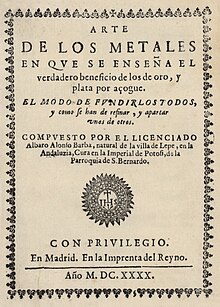| This article includes a list of general references, but it lacks sufficient corresponding inline citations. Please help to improve this article by introducing more precise citations. (March 2024) (Learn how and when to remove this message) |
Alvaro Alonso Barba was a secular Catholic priest and metallurgist born in Lepe, a town in the province of Seville, in Andalusia, Spain, in 1569. He was baptized on November 15, 1569, which, according to the customs of Spain at that time, indicates that he was born a few days earlier. Antonio (1786) says, "Baeticus ex oppido Lepe, apud Potosi"; hence Barba is assumed to be of Andalusian origin, from the ancient Roman province of Baetica. He held a degree in theology and traveled to Peru around 1606, holding priestly positions in churches in various localities.
He lived at Potosí during the period when its silver mines were most productive and luxury among the Spanish residents and mine owners had nearly reached its height. Barba divided his time between his priestly duties and a close study of the ores of this region and their treatment. There had been, since 1570, a complete revolution in the treatment of silver ores, through the application of mercury, and a number of improvements followed, of which Barba had knowledge.

As indicated in his book, he also dedicated himself to conducting experiments related to alchemy. In 1609, in an attempt to solidify mercury, he tested the effect of various substances, observing that when he used powdered silver ore, metallic silver appeared along with the mercury. He correctly interpreted that it was not a transmutation, but rather that the silver came from the ore and could be extracted using mercury. He invented the pan amalgamation process (in Spanish the cazo or fondo process) for extracting silver from ore by mixing it with salt and mercury and heating it in shallow copper vessels. In 1640 he published in Madrid a book entitled Arte de los Metales, the earliest work on South American ores and minerals. It includes information on mineral localities in Bolivia. The book has been republished in Spanish, French, English and German.
Alvaro Alonso Barba died in the town of Triana, in the province of Seville, on October 25, 1662.
Notes
- ^ Bargalló, Modesto (1969). La amalgamación de los minerales de plata en Hispanoamérica colonial [The amalgamation of silver ores in colonial Spanish America] (in Spanish). Mexico: Compañía Fundidora de Fierro y Acero de Monterrey. pp. 300–314.
- Alonso Barba, Alonso (1640). Arte de los Metales [Art of metals] (in Spanish) (1st ed.). Madrid, Spain: Imprenta del Reyno. pp. 58–59.
- Calvo, M. & Sevillano, E. (1998). "Alvaro Alonso Barba y el Arte de los Metales". Química e Industria. 45: 106–111.
References
- Attribution
 This article incorporates text from a publication now in the public domain: Bandelier, AD. F. (1913). "Alvaro Alonzo Barba". In Herbermann, Charles (ed.). Catholic Encyclopedia. New York: Robert Appleton Company. Cites:
This article incorporates text from a publication now in the public domain: Bandelier, AD. F. (1913). "Alvaro Alonzo Barba". In Herbermann, Charles (ed.). Catholic Encyclopedia. New York: Robert Appleton Company. Cites:
- Pinelo, Epitome, etc., (1738), II;
- Nicolas Antonio, Bibliotheca hispana nova (A Library of New Spain; Madrid, 1786)
- Mendiburu, Dicc. Hist. -biog., etc., (Lima, 1876), II;
- Relaciones geograficas de Indias (Madrid, 1885), II, Appendix iv.
External links
- Josep M. Barnadas (December 1988). "Alvaro Alonso Barba (1569-1662): Investigaciones sobre su vida y obra". Isis. 79 (4): 730–731. doi:10.1086/354900. JSTOR 234802.